Hermanson G. Bioconjugate Techniques, Second Edition
Подождите немного. Документ загружается.

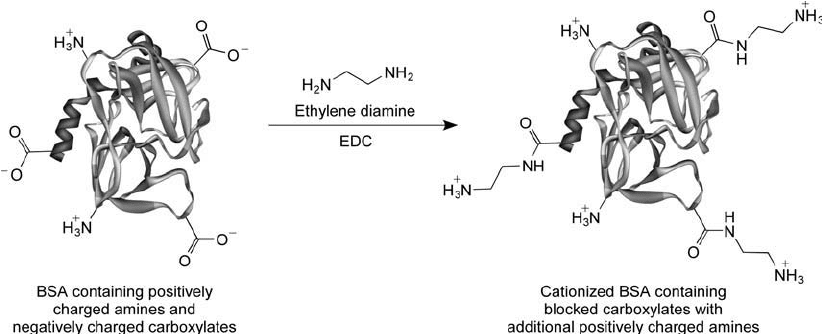
750 19. Preparation of Hapten–Carrier Immunogen Conjugates
C-terminal carboxylate), forming an amide bond with a 2-carbon spacer containing a termi-
nal primary amine group. Since the negative charge contributions of the native carboxylates
are masked and positively charged amines are created in their place, the result of this process
is a signifi cant rise in the protein ’s pl. Cationization performed according to published proce-
dures alters the net charge of BSA from a pl of about 5.1 (Cohn et al., 1947) to over pl 11.0
(Muckerheide et al ., 1987).
The highly positive charge of cBSA dramatically increases its immunogenicity. The positive
character of the molecule aids in its binding to APC in vivo, the fi rst step in antibody produc-
tion. The protein thus gets incorporated into the APCs faster than molecules having lower pI val-
ues. It also gets processed at an accelerated rate, producing a quicker immune response, and one
that occurs with greater concentrations of specifi c antibody (Domen et al., 1987; Muckerheide
et al., 1987b; Apple et al., 1988; Domen and Hermanson, 1992; Chen et al., 2002).
cBSA used as a carrier protein also induces a similar increase in the production of antibody
against any attached hapten molecules. Even when haptens are coupled through cBSA ’s amine
residues, the overall charge of the molecule remains basic enough to augment the immune
response beyond that usually obtained using other carriers. This augmentation occurs even when
the attached molecule is not merely a hapten, but a larger antigen macromolecule. Conjugation
of a complete antigen (a molecule able to generate an immune response on its own) to cBSA
causes an increased immune response against the antigen beyond that normally obtainable for
the native antigen administered in unconjugated form (Domen and Hermanson, 1992).
The effectiveness of cBSA as a carrier for peptides was investigated using arginine vaso-
pressin (AV) as the hapten. Figure 19.3 shows the antibody concentration resulting after injec-
tion of the AV–cBSA conjugate intraperitoneally (i.p.) into BDF
1
female mice. As a control,
native BSA (nBSA) was similarly conjugated with AV and administered in a second set of mice
under identical conditions. The antibody concentrations in the sera were monitored periodically
by enzyme-linked-immunosorbent assay (ELISA). The antibody response resulting from a set of
mice injected with unconjugated peptide was subtracted in all cases. All injections were done
Figure 19.2 cBSA is formed by the reaction of ethylene diamine with BSA using the water-soluble carbodiimide
EDC. Blocking of the carboxylate groups on the protein combined with the addition of terminal primary amines
raises the pI of the molecule to highly basic values.
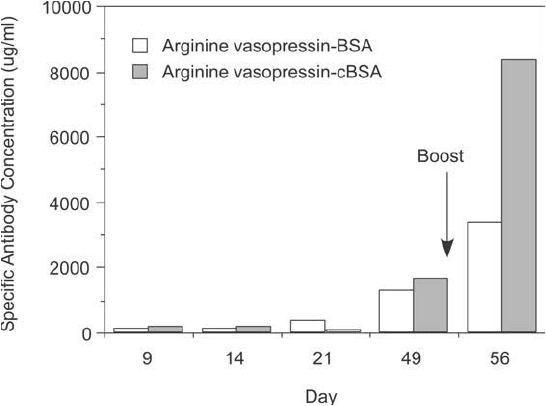
using 100 g of conjugate mixed with an equal volume of alum (22.5 mg/ml aluminum hydrox-
ide) as adjuvant.
After the boost, the group of mice receiving the AV–cBSA conjugate generated over twice
the antibody response as the group receiving the peptide conjugated to nBSA.
In a similar study, OVA conjugated to cBSA was compared to the same protein conjugated
to nBSA and also OVA administered in an unconjugated form in mice. Figure 19.4 shows that
before and after the boost, the OVA–cBSA conjugate resulted in much higher antibody con-
centrations than either the OVA–nBSA conjugate or OVA injected in an unconjugated form.
Similar results were obtained for a conjugate of human IgG with cBSA ( Figure 19.5 ).
A corollary to the use of cBSA as a carrier protein is that its increased immune response
often abrogates the use of complete Freund ’s adjuvant, which is a source of concern because of
its potential side-effects in animals. A relatively innocuous mixture with alum is usually all that
is required as adjuvant to result in good antibody production.
As mentioned previously for KLH, DMSO may be used to solubilize hapten molecules that
are rather insoluble in aqueous environments. Conjugation reactions may be done in solvent/
aqueous phase mixtures to maintain some solubility of the hapten once it is added to a buff-
ered solution. BSA remains soluble in the presence of up to 35 percent DMSO, becomes slightly
cloudy at 40 percent, and precipitates at 45 percent (v/v).
Thyroglobulin and OVA
Thyroglobulin and ovalbumin (OVA) are used less often as carriers, but they are particularly
valuable as non-relevant carriers in ELISA tests designed to measure the antibody response
Figure 19.3 The effectiveness of cBSA as an immunogen can be seen by the comparison of specifi c antibody
response in mice to AV coupled to both nBSA cBSA. The quantity injected was standardized according to the
amount of AV present. The cationized carrier results in higher concentrations of antibody produced against the
peptide than the immunogen made with nBSA.
2. Types of Immunogen Carriers 751
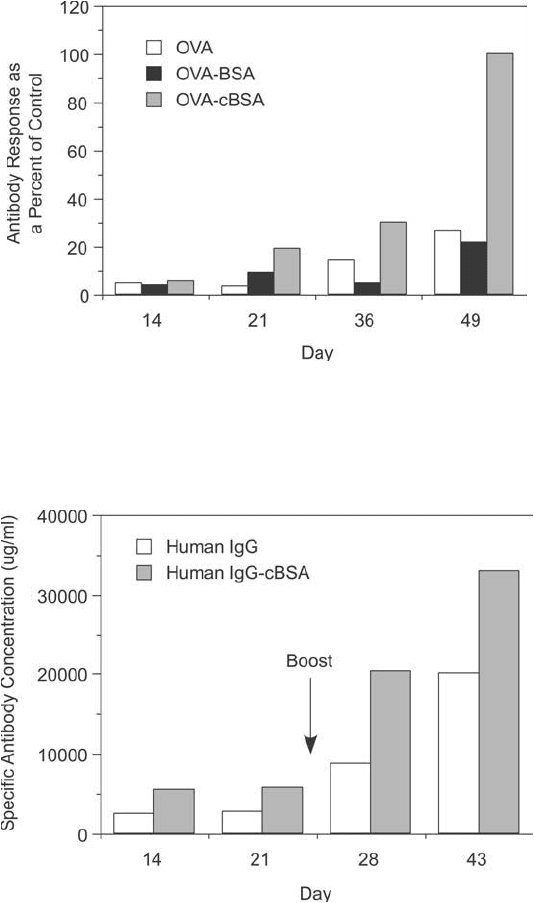
752 19. Preparation of Hapten–Carrier Immunogen Conjugates
after injection of an immunogen conjugate. Since an antibody response would be directed both
against the carrier and the attached hapten, an ELISA done to quantify specifi c antibody that
only interacts with the hapten must not utilize the same carrier in the conjugate coated on
the microplates. If the identical carrier conjugate is used for the ELISA as was used in the
Figure 19.4 cBSA even can increase the specifi c antibody response to large proteins coupled to it. This graph
shows a comparison of the relative antibody response in mice to injections of OVA, either in an unconjugated
form or conjugated to nBSA or cBAS. The quantity injected was standardized according to the amount of OVA
present. The highly basic cBSA molecule modulates the immune response to enhance the production of antibod-
ies toward even proteins conjugated with it.
Figure 19.5 Human IgG was injected in mice either in an unconjugated form or crosslinked with cBSA. The
quantity injected was standardized according to the amount of IgG present. A greater antibody response was
obtained using the cBSA conjugate.
original immunization, the test results will be skewed by the contribution of carrier-specifi c anti-
bodies. For this reason, a non-relevant carrier—one that is not recognized by the products of
the immune response—must coupled with hapten and used for the ELISA test.
Since OVA and BSA possess some immunologically similar epitopes, a population of the
antibodies produced against one often will cross-react against the other. Therefore, OVA can-
not function as a non-relevant carrier for BSA and vice versa. Either OVA or BSA, however,
may be used as non-relevant carriers for KLH, thyroglobulin, or the various toxoid proteins
used as immunogen conjugates.
OVA comprises about 75 percent of the total protein in hen egg whites. It is a phosphoprotein
containing one N-glycosylation site and 386 amino acids. The protein contains 20 lysine residues,
14 aspartic acids, and 33 glutamic acid groups. This gives a total of 20 -amines, 1 N-terminal
amine, 47 side-chain carboxylates, and 1 C-terminal carboxylate for conjugation reactions. The
majority of acidic groups gives the protein a pI of 4.63. Additional sites of modifi cation include
4 sulfhydryl groups, 10 tyrosines, and 7 histidine residues. OVA is sensitive to temperature
(above 56°C), electric fi elds, and vigorous mixing. Care should be taken in handling the protein
to prevent denaturation and subsequent precipitation.
One advantage of OVA is its extreme solubility characteristics in the presence of DMSO.
A sparingly soluble hapten molecule may be dissolved in this solvent and added to an aqueous
OVA reaction mixture to maintain solubility of the molecule during conjugation. OVA is soluble
at up to 70 percent DMSO, becomes cloudy at 75 percent, and precipitates at 80 percent (v/v).
Thyroglobulin is a prohormone protein which is synthesized and stored in the thyroid gland.
Specifi c proteolytic action on the protein in vivo causes the release of triiodothyronine and
thyroxine, low-molecular weight amino acid derivatives that affect metabolic rate and oxygen
consumption. Thyroglobulin is a large, multi-subunit protein composed of several polypep-
tide chains (MW 670,000). Its acidic pl (4.7) refl ects the abundance of carboxylate groups.
Thyroglobulin is also glycosylated, containing about 8–10 percent carbohydrate. Its use as an
immunogen carrier protein is less frequent than that of KLH or BSA.
Tetanus and Diphtheria Toxoids
Toxoid proteins are biologically inactivated forms of native toxins. The most often used toxoid
is tetanus toxoid, but diphtheria-derived toxoids and other proteins also are used occasionally
(Anderson et al., 1989). Tetanus toxoid (MW 150,000) has 106 amine groups, 10 sulfhydryls,
81 tyrosine residues, and 14 histidines that may participate in conjugation reactions with hap-
ten molecules (Bizzini et al., 1970). Diphtheria toxoid is derived from a protein secreted by cer-
tain strains of Corynebacterium diphtheriae. Its molecular weight is approximately 63,000 D
(Collier and Kandel, 1971). Both protein toxoids can be used to couple haptens through any of
the chemical reactions described in this section. They generate strong immunological responses
in vivo .
2.2. Liposome Carriers
Liposomes are artifi cial structures composed of phospholipid bilayers exhibiting amphiphilic
properties (Chapter 22). In complex liposome morphologies, concentric spheres or sheets of lipid
bilayers are usually separated by aqueous regions that are sequestered or compartmentalized
2. Types of Immunogen Carriers 753
754 19. Preparation of Hapten–Carrier Immunogen Conjugates
from the surrounding solution. The phospholipid constituents of liposomes consist of hydro-
phobic lipid tails connected to a head constructed of various glycerylphosphate derivatives. The
hydrophobic interaction between the fatty acid tails is the primary driving force for creating
liposomal bilayers in aqueous solutions.
The morphology of a liposome may be classifi ed according to the compartmentalization of
aqueous regions between bilayer sheets. If the aqueous regions are sequestered by only one
bilayer each, the liposomes are called unilamellar vesicles (ULV). If there is more than one
bilayer surrounding each aqueous compartment, the liposomes are termed multilamellar vesi-
cles (MLV). ULV forms are further classifi ed as to their relative size, although rather crudely.
Thus, there can be small unilamellar vesicles (SUV; usually less than 100 nm in diameter) and
large unilamellar vesicles (LUV; usually greater than 100 nm in diameter). With regard to MLV,
however, the bilayer structures cannot be easily classifi ed due to the almost infi nite number of
ways each bilayer sheet can be associated and interconnected with the next one. MLVs typi-
cally form large complex honeycomb structures that are diffi cult to classify or reproduce.
The overall composition of a liposome—its morphology, composition (including a variety of
potential phospholipids and the degree of its cholesterol content), charge, and any attached func-
tional groups—can affect the antigenicity of the vesicle in vivo (Allison and Gregoriadis, 1974;
Alving, 1987; Therien and Shahum, 1989). When liposomes are used as carriers for immuniza-
tion purposes, the haptens or antigens usually are attached covalently to the head groups using
various phospholipid derivatives and crosslinking strategies (Derksen and Scherphof, 1985).
Most often, these derivatization reactions are done off of phosphatidylethanolamine constituents
within the liposomal mixture. The primary amine modifi cation of the glycerylphosphate head
group of phosphatidylethanolamine provides an ideal functional group for activation and sub-
sequent coupling of hapten molecules (Shek and Heath, 1983). Stock preparations of activated
liposomes may be prepared and lyophilized to be used as needed in coupling hapten molecules
(Friede et al., 1993). Conjugates of liposomes with peptides or other molecules have been used
to target cells in vivo for disease therapy (Du et al., 2007). All of the amine-reactive conjuga-
tion methods discussed in this section may be used with phosphatidylethanolamine-containing
liposomes; however see Chapter 22 for a more complete discussion of the unique considerations
associated with conjugation of molecules to liposomes.
2.3. Synthetic Carriers
Synthetic molecules may be used as immunogen carriers if they are designed with the appropri-
ate functional groups to couple hapten molecules. These carriers may consist of simple polymers
such as poly-L-lysine, poly-L-glutamic acid, Ficoll, dextran, polyethylene glycol, or dendrimers
(Lee et al., 1980; Fok et al., 1982; Boyle et al., 1983; Hopp, 1984; Wheat et al., 1985). Coupling
of hapten molecules to the principle functional groups of these polymers can produce immuno-
genic conjugates that may be injected in animals to generate a specifi c antibody response.
Poly-L-lysine may be coupled to carboxylate-containing molecules using the carbodiimide
conjugation procedure to yield amide linkages (Chapter 3, Section 1). Homobifunctional or
heterobifunctional crosslinking agents also may be used with poly-
L-lysine, such as in the use
of sulfo-SMCC (Chapter 5, Section 1.3). The polymer can be used as well for coupling hap-
ten molecules and subsequent coating of microplates for ELISA procedures (Gegg and Etzler,
1993). Conversely, poly-
L-glutamic acid may be coupled to amine-containing haptens by the
same carbodiimide protocol. Ficoll and dextran carriers may be activated by mild sodium peri-
odate oxidation to generate reactive aldehyde groups (Chapter 1, Section 4.4 and Chapter 25,
Section 2.1). Coupling to amine-containing haptens then may be done by reductive amination
(Chapter 2, Section 5). Polyethylene glycol chemistry involves alternate activation and coupling
schemes that are addressed in Chapter 25, Section 1.
A unique synthetic molecule that can be used as a carrier is the so-called multiple antigenic
peptide (MAP) (Posnett et al., 1988; Tam, 1988). The MAP core structure is composed of a
scaffolding of sequential levels of poly-
L-lysine. The dendritic molecule is constructed from a
divalent lysine compound to which two additional levels of lysine are attached. The fi nal MAP
compound consists of a symmetrical, octavalent primary amine surface to which hapten mol-
ecules may be attached. Coupling of up to eight peptide haptens to the MAP core yields a highly
immunogenic complex having a molecular weight of typically greater than 10,000. The nature of
the MAP carrier makes it ideal for remarkably defi ned conjugates useful in vaccine development.
One particularly novel carrier was reported to consist of 50–70 nm colloidal gold particles of
the type often used in cytochemical labeling techniques for microscopy (Pow and Crook, 1993)
(Chapter 24). Adsorption of peptide antigens onto gold and subsequent injection of the com-
plex into rabbits in an adjuvant mixture resulted in rapid production of antibody of extremely
high titer. The resultant antibodies could be used in immunocytochemistry at dilutions from
1-in-250,000 down to 1-in-1,000,000, which is orders-of-magnitude beyond the dilutions typi-
cally used with lower-titer antibodies.
3. Carbodiimide-Mediated Hapten–Carrier Conjugation
The coupling chemistry used to prepare an immunogen from a hapten and carrier protein is
an important consideration for the successful production and correct specifi city of the result-
ant antibodies. The choice of crosslinking methodology is governed by the functional groups
present on the carrier and the hapten as well as the orientation of the hapten desired for appro-
priate presentation to the immune system. An associated concern is the potential for antibody
recognition and cross-reactivity toward the crosslinking reagent used to effect the conjugation.
If antibodies are generated against the crosslinker bridge connecting the carrier with the hap-
ten, then this may dilute the desired antibody response against the hapten. The use of a zero-
length crosslinking procedure mediated by the water-soluble carbodiimide EDC eliminates this
problem, since no bridging molecule is introduced between the hapten and carrier.
The reactions involved in an EDC-mediated conjugation are discussed in Chapter 3, Section
1.1 ( Note: EDC is 1-ethyl-3-(3-dimethylaminopropyl) carbodiimide hydrochloride; MW 191.7
and is sometimes referred to as EDAC). The carbodiimide fi rst reacts with available carboxylic
groups on either the carrier or hapten to form a highly reactive o-acylisourea intermediate. The
activated carboxylic group then can react with a primary amine to form an amide bond, with
release of the EDC mediator as a soluble isourea derivative. The reaction is quite effi cient with
no more than 2 hours required for it to go to completion and form a conjugated immunogen.
Since most peptide haptens contain either amines or carboxylic groups available for cou-
pling, EDC-mediated immunogen formation may be the simplest method for the majority of
hapten–carrier protein conjugations. Figure 19.6 shows the coupling of a carrier protein to a short
peptide molecule through its amine terminus. It should be kept in mind, however, that this type
of conjugation may occur at either the C- or N-terminal of the peptide or at any carboxyl- or
3. Carbodiimide-Mediated Hapten–Carrier Conjugation 755
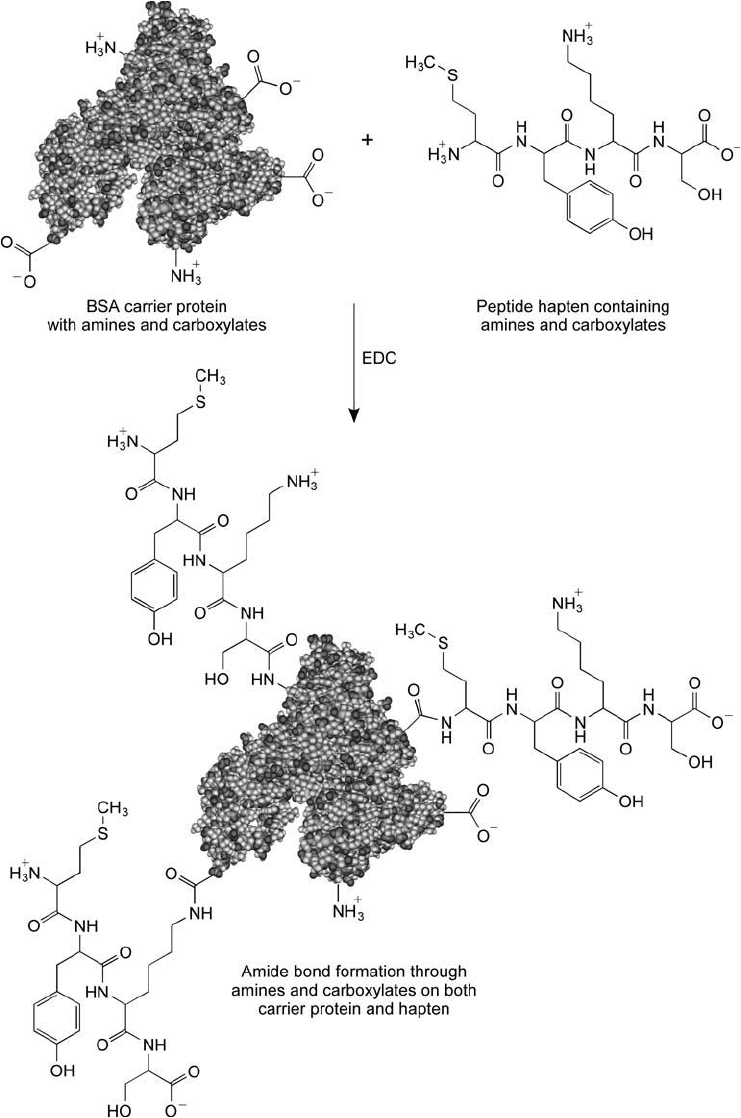
Figure 19.6 Peptide haptens are easily conjugated to carrier proteins using the water-soluble carbodiimide EDC.
amine-containing side chains. Therefore, this method probably should be avoided if a particularly
interesting part of the peptide contains groups which may be blocked or undergo coupling using
the carbodiimide reaction. Also, when using peptides rich in Lys, Glu, or Asp, an unacceptable
level of hapten crosslinking may occur upon conjugation, and thus change the antigenic structure
of the resulting immunogen. However, some crosslinking or polymerization of the peptide on
the surface of the carrier actually may be benefi cial to the immunogenicity of the peptide, and
thus create an even greater antibody response. Some investigators even advocate using no carrier
protein when a peptide hapten is involved: merely polymerizing the peptide in the presence of
EDC may result in a complex of high enough molecular weight to be immunogenic by itself. In
general, EDC coupling is a very effi cient, one-step method for forming a wide variety of peptide-
carrier protein immunogens.
Figure 19.7 shows the results of an EDC conjugation study comparing a reaction done at
pH 4.7 (A) to one done at pH 7.3 (B and C), with and without added sulfo-NHS (see Chapter 3,
Section 1.2). The graphs show the elution profi les of a gel fi ltration separation after conjugation.
In each case, a blank run done without the addition of EDC illustrates the separation of the pro-
tein carrier (the fi rst peak) from the lower-molecular weight peptide and reagent peak (the second
peak). Decrease in the peptide peak is indicative of successful conjugation. Complete recovery
of the total absorbance at 280 nm usually does not occur, presumably due to a decrease in the
peptide’s absorptivity as it is conjugated or polymerized. Staros ’ method of adding sulfo-NHS
to form an intermediate active ester that subsequently reacts with an amine to form the amide
bond does not work as well due to excessive conjugation (causing precipitation in most cases)
and interference from the eluting sulfo-NHS peak. The reaction proceeds with similar yields at
either acid or neutral pH. Thus, the effi ciency of an EDC conjugation reaction is approximately
the same from pH 4.7 to physiological conditions.
Figure 19.8 shows the result of the conjugation of the dipeptide tyrosyl-lysine to BSA using
various concentrations of EDC. Again, the elution profi le shows the gel fi ltration pattern
resulting after the reaction. The fi rst peak is the protein carrier while the second is the peptide.
Progressive decrease in the peptide peak with increasing amounts of EDC added to the reac-
tion mixture correlates to increased conjugation yields. A side reaction to EDC conjugation of
haptens that contain both an amine and a carboxylate group is hapten polymerization. This is
revealed in the movement of the peptide peak toward higher-molecular weights (e.g., decreased
time of elution) with increasing amounts of EDC added to the reaction.
Figure 19.9 illustrates the conjugation of [Met5]-enkephalin with BSA using EDC. The gel fi l-
tration profi le after crosslinking reveals that the peptide peak effectively disappears upon complete
conjugation with the carrier protein. With nicely soluble peptides such as this one, the immuno-
gen remains freely soluble even at high modifi cation levels. For less soluble peptides or haptens,
reducing the amount of EDC addition may be necessary to maintain solubility in the conjugate.
To illustrate the similarity of an EDC conjugation reaction using a different carrier protein,
but the same peptide, Figure 19.10 shows the gel fi ltration separation after conjugation of
[met5]-enkephalin to OVA. The uptake of peptide upon addition of EDC is almost identical to
that observed when conjugating to BSA. This is logical, since on a per mass basis, there is very
little difference between these proteins in the amount of amines or carboxylates available for
conjugation.
Figure 19.11 shows the conjugation of tyrosyl-lysine to KLH using various concentra-
tions of EDC. The elution profi le shows the gel fi ltration pattern resulting after the reaction.
Progressive decrease in the peptide peak (peak 2) with increasing amounts of EDC correlates to
3. Carbodiimide-Mediated Hapten–Carrier Conjugation 757
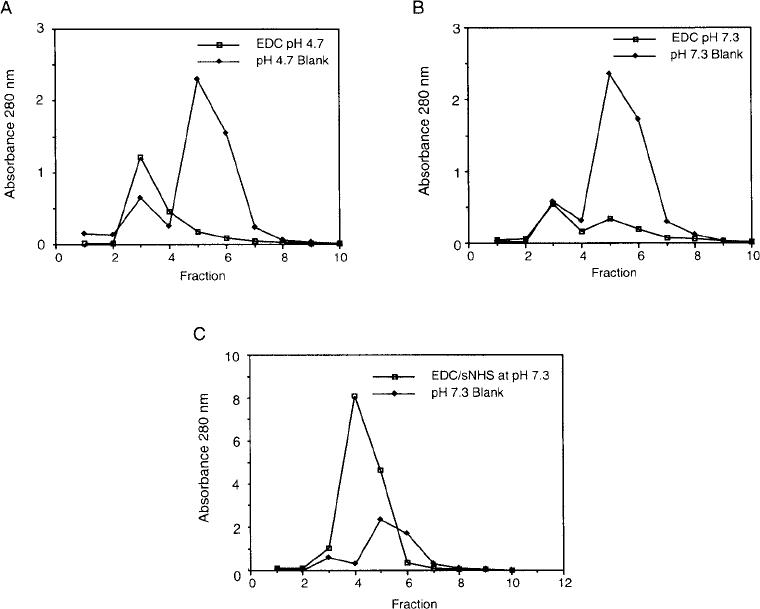
758 19. Preparation of Hapten–Carrier Immunogen Conjugates
increased conjugation (or polymerization) yields. Despite the extremely high-molecular weight
of KLH compared to the other commonly used carriers, the conjugation reaction using EDC
again proceeds with virtually identical results to the similar study shown in Figure 19.8 using
BSA as the carrier. In fact, superimposing the two studies on the same graph demonstrates the
reproducibility of an EDC-facilitated reaction ( Figure 19.12 ).
Due to the high-molecular weight of KLH and its solubility characteristics, the
conjugation of this protein to some haptens can result in precipitation of the complex. This
is especially true if the level of EDC addition is similar to the EDC concentrations used with
lower-molecular weight carriers such as BSA or OVA. Figure 19.13 shows the elution profi le
Figure 19.7 To assess the effectiveness of an EDC conjugation reaction of a peptide with a carrier protein,
glycyl-tyrosine was coupled to BSA using various conditions. The graphs show a gel fi ltration profi le on
Sephadex G-25 after completion of the conjugation reaction. The fi rst peak eluting off the column is the higher-
molecular weight carrier, while the second peak is excess peptide. The elution profi les demonstrate that the
carbodiimide reaction proceeds with nearly equal effi ciency at pH 4.7 (A) or pH 7.3 (B). In each graph, a com-
parison is shown between the separation of peptide and carrier without addition of EDC and the same mixture
after reaction with EDC. Depletion of the peptide peak in the EDC-containing elution profi les indicates uptake
of glycyl-tyrosine in the carrier conjugate. Some polymerization of peptide is also possible using this method, as
evidence by movement of the peptide peak toward higher-molecular weight elution points. Addition of sulfo-
NHS to the reaction caused precipitation problems as well as obscuring the separation due to the absorbance of
excess sulfo-NHS (C).
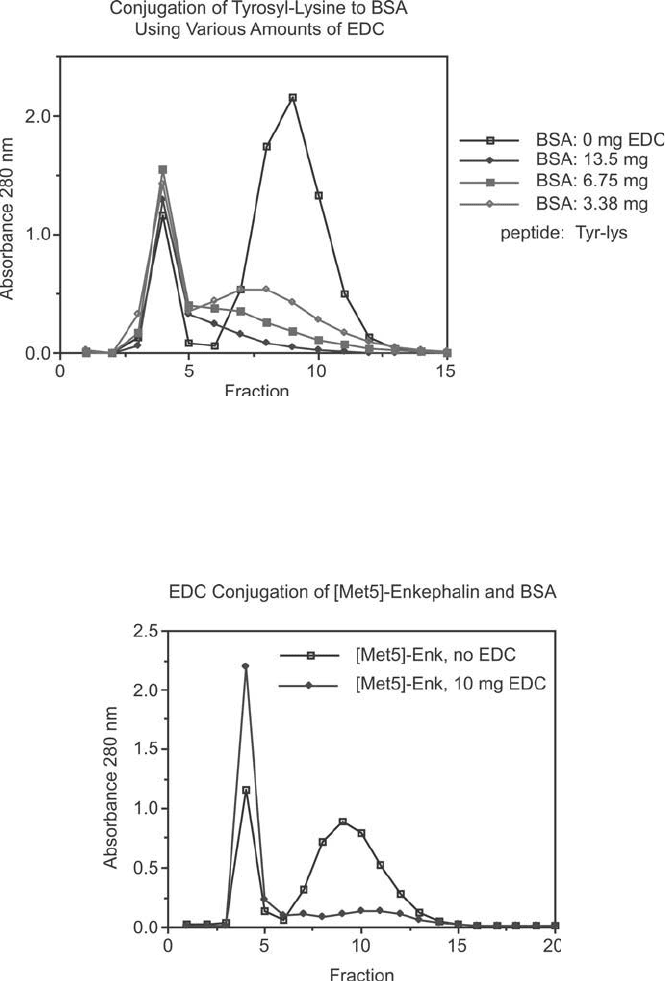
Figure 19.9 Conjugation of the biological peptide [Met5]-enkephalin to BSA using EDC. The graph shows
the gel fi ltration profi le (on Sephadex G-25) after completion of the conjugation reaction. A blank run with no
added EDC was done to illustrate the peak absorbance that would be obtained if no conjugation took place.
With addition of 10 mg of EDC to a reaction mixture consisting of 2 mg of BSA plus 2 mg of peptide, nearly
complete conjugate formation was obtained.
Figure 19.8 To study the conjugation of peptides to carriers using different levels of EDC, tyrosyl-lysine was
conjugated to BSA and separated after the reaction by chromatography on a Sephadex G-25 column. As the
EDC level was increased in the reaction, more peptide reacted and the peptide peak (the second peak) was
depleted. The absorbance of the carrier peak (the fi rst one) increases as more peptide is conjugated.
3. Carbodiimide-Mediated Hapten–Carrier Conjugation 759
